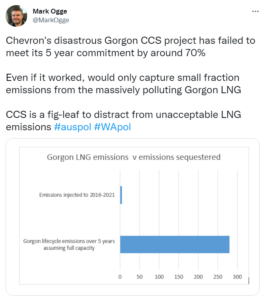1. It can’t deliver in time or at scale
Capturing, transporting and burying millions of tonnes of carbon dioxide from coal and gas-burning power stations is impractical and expensive. So much so that even this coal baron admits that CCS ‘does not work’ and ‘is just cover for the politicians.’
Whether or not CCS ever becomes a viable technology, the United Nations Development program has said it “will arrive on the battlefield far too late to help the world avoid dangerous climate change”.
Of course fossil fuel lobbyists are always pointing to the future, saying that CCS is just on the horizon. The problem is they’ve literally been saying that for decades! In this Lateline report from 2009, a coal industry executive says that commercial CCS plants will be up and running in Australia by 2015. Well, we’re still waiting …
.embed-container { position: relative; padding-bottom: 56.25%; height: 0; overflow: hidden; max-width: 100%; } .embed-container iframe, .embed-container object, .embed-container embed { position: absolute; top: 0; left: 0; width: 100%; height: 100%; }
2. It wastes water and energy
Because of the energy it takes to capture, compress and transport greenhouse pollution, CCS uses a huge chunk of the energy the power station produces in the first place. (They also use a third more water than conventional coal-fired power stations).
As coal power becomes increasingly expensive and uneconomic, this would only compound the problem. Especially as clean energy and storage continues to get cheaper and cheaper.
3. It creates a long-term, potentially dangerous liability
If CCS is going to work it needs to ensure that greenhouse pollution stays underground forever. Can the coal industry really guarantee that this will happen? And who will accept liability for fixing the problem if/when something occurs?
4. It’s expensive and undermines funding for sustainable solutions
Despite Australian governments pouring more than $4 billion into CCS research since 2003, there is very little to show for it. Australia has only one commercial-scale CCS project in Western Australia, which is an expensive failure (read more below).
Recent research shows that attaching CCS to coal and gas power stations would make the energy at least six times more expensive than electricity generated from clean wind power backed by battery storage.
In fact, this report by CO2CRC found retrofitting a hypothetical 2100-megawatt brown coal-fired power station in Victoria would “conservatively” cost an incredible $2.45 billion per boiler.
Despite these staggering costs, our federal government is still throwing more money at CCS technology. Even coming up with ways to pay big fossil fuel companies carbon credits so they can continue burning coal and gas!
We need to be cutting climate pollution, not encouraging more. And every cent spent on CCS is a cent not going to proven clean technologies.
5. Trial projects have over-promised and under-delivered
Chevron’s Gorgon LNG gas plant features Australia’s only CCS project – and the biggest in the world. But after 5 years and more than $3 billion (including $90 million subsidised by taxpayers), the project is only capturing a tiny fraction of the emissions generated. This failure has cost our climate millions of tonnes more carbon pollution.
Many other CCS projects have been scrapped around the world, with none still able to deliver on time, on budget, or capture the amount of carbon they have promised.
6. It’s completely unnecessary
Detailed analysis shows that Australia, one of the sunniest and windiest countries on earth, can be powered by 100% clean energy — no CCS required.
